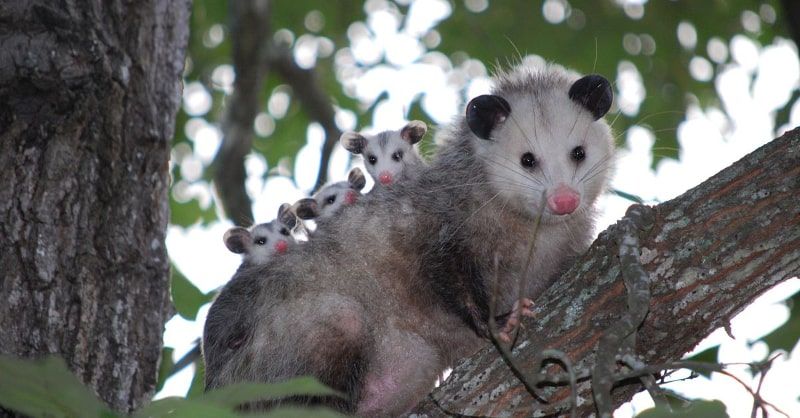Some Curious Facts about the Tlacuaches (Opossum) in Mexico
Tlacuaches are harmless, and incapable of transmitting rabies. They have poor eyesight and are slow. Quintana Roo and Campeche are the only places that have protected areas.

An animal that is often not appreciated because it is considered "ugly" is the tlacuache or opossum, and despite appearing to be a vulnerable species, it has been one of the most resistant to changes in climate and conditions on the planet.
There are eight tlacuache species in Mexico, five of which inhabit the Yucatan Peninsula. These are the Norteño or Northern tlacuache (Didelphis virginiana), the Sureño or Southern tlacuache (Didelphis marsupialis), the Gray Macaw (Philander opossum), and the Gray Mouse (Tlacuatzin canescens), and the Mexican Mouse (Marmosa mexicana).
The Sureño tlacuache is the most common in this area and it is necessary to know it in order not to confuse it with other species. These animals are very special, they belong to the group of marsupial mammals, such as kangaroos or koalas. Their history dates back to the time of the dinosaurs when the planet had a supercontinent called Pangea.
Back then there were already the tlacuaches, a species that lived hidden and came out only at night, they were very small. When Pangea was divided into two continents, the mammals in it were also divided; to the south (in what is now South America and Oceania) there were marsupials.
There are monotreme mammals, which are those that lay eggs; marsupials, which come out of the mother's vagina very small and finish growing in the pouch known as the marsupium (to which the tlacuaches belong) and placentals, which keep their young in the mother's body until they reach an important degree of development.
Tlacuaches, survivors of prehistory
South America had many marsupials before and 3.5 million years ago the Central American bridge is formed, which connects South America with North America, and there comes an epic battle that lasted thousands of years known as the great American biological exchange, characterized because many species of life from the south begin to migrate to the north.
Plants, fungi, fish, mammals, birds, reptiles, and also those of the north travel to the south, there begins the fight for resources and the marsupials of the south lose the battle against the placentals of the north and only very few marsupials remain as survivors of this great battle and these survivors are the family of the tlacuaches.
When humans appear, several stories are generated and one of them has to do with the tlacuache, as it is said that it has a bald tail because it was rummaging through the kingdom of the gods and suddenly came to the fire, its tail burned, it ran and came to humans so that the tlacuache brought us the fire. It is like a kind of Prometheus but in the Mesoamerican culture.
The name tlacuache is related to the Nahuatl tlacuatzin (tla, fire; cua, to nibble, to eat, and tzin, boy) which means "the little one that eats fire" or "the one that is always hungry". When the Europeans arrived they baptized it "sarihuella" and in English, it is "opossum".
What do tlacuaches eat?
The tlacuache sureño (southern opossum) is omnivorous, that is, it feeds on everything it finds, mainly insects; it can eat carrion, fruits, etc. The females have two or three vaginas and in all of them they can engender and the males have a bifurcated penis (with two tips) and the testicles are located in front of the phallus, unlike other animals.
People think that tlacuaches are similar to rats and that's why they don't like them, but the reality is that humans are more related to rats than tlacuaches because we are placentals and they are marsupials. A tlacuache is more related to a kangaroo than to a rat, they are very different evolutionarily, and they have nothing to do with each other.
In each birth, tlacuaches can have five to nine offspring and reproduce about three times a year. They live for two to four years; they measure between 45 and 60 centimeters and weigh approximately 2 kilograms. April and May is their breeding season. They are not classified as endangered. Their predators are jaguars, big cats, and snakes such as boas.
Tlacuaches have a peculiarity and it is that when they feel threatened they play dead and it is not something they control, it is like a reflex they have, they go into a catatonic state. In the Yucatan Peninsula, this species is very common and adapts well to human activity; it is possible to find them in the cities, where they normally scan the garbage in search of food.
What to do if we encounter an opossum
If we find it during the night prowling around an outbuilding, it should not be disturbed or approached, since this stresses it to a great extent. When frightened, they tend to drool abundantly, which indicates that our presence is making them uncomfortable and we should move away from them.
Finding them during the day may imply that there is a problem, since they may be hungry, trapped, sick, or injured; in any of these cases, they should not be handled without knowing how to do it, since they can transmit diseases. The best thing to do is to contact the authorities and wait for instructions on what to do. The Secretariat has contact with the people trained to handle these animals.
If you find a dead animal, make sure that it is dead and not in a state of thanatosis; it is necessary to contact the authorities so that they can notify the appropriate people of the carcass. Dead females may have living offspring in their marsupium, which can be recovered and raised by trained personnel.
What NOT TO DO if we encounter a possum
Do not confuse them with rats, as this can lead to poor treatment and, as we already know, they are very different animals.
Do not handle them without knowing how to do it.
Under no circumstances should they be killed or kept as pets because they are not domestic animals; in fact, this is prohibited by the reserve's Internal Regulations.
In case of finding an injured or trapped animal
In case of finding an injured or trapped tlacuache and not having the support of trained personnel, you can act as follows:
A person should approach it carefully, as it will feel threatened, seeing us as a possible predator, and could attack. Even if they appear to be still or asleep, they may react violently when captured.
If the animal is trapped, check if it is possible to release it without having direct contact with it. If not, you should hold it firmly by the tail and release it in the area of the Reserve closest to its dependency. It is important to use leather gloves.
If it is injured, it should be held firmly by the tail and placed in a cardboard or wooden box or a well-covered dog carrier cage so that it feels safe and with holes that allow it to breathe.
He should be kept in captivity until trained handlers are contacted. In the meantime, he should be kept in good condition and provided with water, fruit, and cat kibble.
Do not attempt to care for tlacuache yourself, as there are trained people who can provide adequate care.
Curious Facts About Tlacuaches
These are just a few curious facts about tlacuaches that few people know and that may surprise some people. It is a peculiar animal, but in most cases, there is a lot of misinformation about it. However, it is only necessary to know a few facts to be surprised and arouse curiosity about this striking mammal. To begin with, the tlacuache is more than 60 million years old, and it has even kept its appearance during all this time, but this is only one of its many interesting features.
Species endemic to Mexico
The tlacuache is a Mexican endemic species that live in both temperate and tropical climates. It is usually found in open and wooded areas, but also urban areas. The areas where tlacuaches are most commonly found are Quintana Roo, Veracruz, Michoacán and Guerrero.
The little one that eats fire
The term tlacuache is derived from the Nahuatl term, tlacuatzin, which translates as "little one that eats fire". This is one of its most curious and least-known facts, all due to a pre-Hispanic myth, as it is said that the tlacuaches stole fire from the gods to give it to men. These animals used to be venerated by Mesoamerican cultures, even on the same level as other animals such as the puma. The tlacuache has been called the Prometheus of Mexico.
Of the kangaroo family
The tlacuaches are marsupials and the only ones in Mexico, that is, they are mammals that have a marsupium, which is a pouch in their body and it is inside it where their young finish their incubation. Therefore, they share some kinship with kangaroos, although this is curious, since their appearance is very similar to that of a rodent, they can be compared to a large rat.
Omnivorous diet
They are omnivores, feeding on insects, fruits, eggs, amphibians, and reptiles. They also eat garbage and trash, which is one of the reasons why they are sometimes seen in urban areas. These animals often contribute to the elimination and prevention of certain pests.
They do not transmit rabies
Many people tend to believe that the opossum carries and transmits the rabies virus, but this is not true. The reason is that they are animals with low body temperature and therefore are not apt to incubate the virus.
They simulate their death
When an opossum feels threatened or in danger, it pretends to be dead by remaining motionless. This is a tactic to protect itself, in this case, predators, for example, lose interest in it and move away.
On the brink of extinction
The tlacuaches are at risk of extinction because they are often hunted, on the one hand. After all, they are mistaken for rats, and on the other hand because of the mistaken belief that they are capable of transmitting the rabies virus. Opossums are also hunted for their meat and fat, which are used to treat diseases and ailments such as arthritis.
In summary, tlacuaches are amazing animals, their appearance is not usually attractive to most people, as they are always compared or even mistaken for large rodents. However, they are marsupials with interesting characteristics, harmless, ancient animals with an incredible history.




